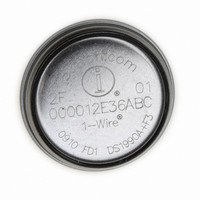DS1922T-F5# Maxim Integrated Products, DS1922T-F5# Datasheet - Page 41

DS1922T-F5#
Manufacturer Part Number
DS1922T-F5#
Description
IBUTTON TEMP LOGGER
Manufacturer
Maxim Integrated Products
Series
iButton®r
Datasheet
1.DS1922L-F5.pdf
(52 pages)
Specifications of DS1922T-F5#
Rohs Information
IButton RoHS Compliance Plan
Memory Size
512B
Memory Type
NVSRAM (Non-Volatile SRAM)
Lead Free Status / RoHS Status
Lead free / RoHS Compliant
The DS1922L/DS1922T require strict protocols to ensure
data integrity. The protocol consists of four types of sig-
naling on one line: reset sequence with reset pulse and
presence pulse, write-zero, write-one, and read-data.
Except for the presence pulse, the bus master initiates
all these signals. The DS1922L/DS1922T can communi-
cate at two different speeds: standard speed and over-
drive speed. If not explicitly set into the overdrive mode,
the DS1922L/DS1922T communicate at standard
speed. While in overdrive mode the fast timing applies
to all waveforms.
To get from idle to active, the voltage on the 1-Wire line
needs to fall from V
from active to idle, the voltage needs to rise from
V
voltage to make this rise is seen in Figure 12 as “ε” and
its duration depends on the pullup resistor (R
and the capacitance of the 1-Wire network attached.
The voltage V
DS1922T when determining a logical level, not trigger-
ing any events.
The initialization sequence required to begin any com-
munication with the DS1922L/DS1922T is shown in
Figure 12. A reset pulse followed by a presence pulse
indicates the DS1922L/DS1922T are ready to receive
data, given the correct ROM and memory function com-
mand. If the bus master uses slew-rate control on the
falling edge, it must pull down the line for t
compensate for the edge. A t
longer exits the overdrive mode, returning the device to
standard speed. If the DS1922L/DS1922T are in over-
Figure 12. Initialization Procedure: Reset and Presence Pulse
ILMAX
past the threshold V
V
IHMASTER
V
ILMAX
V
V
PUP
V
0V
TH
TL
ILMAX
______________________________________________________________________________________
PUP
is relevant for the DS1922L/
below the threshold V
t
Temperature Logger iButton with 8KB
F
MASTER Tx "RESET PULSE"
TH
1-Wire Signaling
RSTL
RESISTOR
. The time it takes for the
duration of 690µs or
t
RSTL
RSTL
PUP
TL
. To get
+ t
) used
F
to
ε
MASTER
drive mode and t
remains in overdrive mode.
After the bus master has released the line, it goes into
receive mode (Rx). Now the 1-Wire bus is pulled to
V
DS2480B driver, through active circuitry. When the
threshold V
for t
the line low for t
master must test the logical state of the 1-Wire line at
t
The t
t
expired, the DS1922L/DS1922T are ready for data com-
munication. In a mixed population network, t
should be extended to minimum 480µs at standard
speed and 48µs at overdrive speed to accommodate
other 1-Wire devices.
Data communication with the DS1922L/DS1922T takes
place in time slots that carry a single bit each. Write
time slots transport data from bus master to slave.
Read time slots transfer data from slave to master. The
definitions of the write and read time slots are illustrated
in Figure 13.
All communication begins with the master pulling the
data line low. As the voltage on the 1-Wire line falls
below the threshold V
their internal timing generator that determines when the
data line is sampled during a write time slot and how
long data is valid during a read time slot.
MSP
PDLMAX
PUP
t
PDH
PDH
.
RSTH
through the pullup resistor or, in the case of a
t
MSP
and then transmit a presence pulse by pulling
, and t
MASTER Rx "PRESENCE PULSE"
window must be at least the sum of t
t
TH
PDL
Data-Log Memory
t
RSTH
is crossed, the DS1922L/DS1922T wait
RECMIN
RSTL
PDL
. To detect a presence pulse, the
is no longer than 80µs, the device
TL
. Immediately after t
, the DS1922L/DS1922T start
t
REC
Read/Write Time Slots
DS1922L/DS1922T
PDHMAX
RSTH
RSTH
41
is
,












